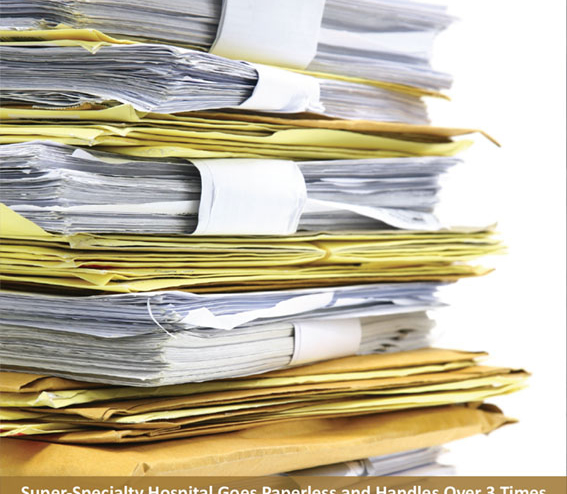Author: Attune Technologies

7 Ways to Stop Revenue Leakage in Your Hospital
Instant fix to plug the drips affecting your profitability.
Every hospital faces financial leakage in some form or the other which is a cause for losing significant revenue and profitability. You already have enough concerns on your plate ranging from competition to new trends to worry about these process and system issues too. But can you afford to ignore it?
We have studied the common revenue leak points in a hospital and here we list 7 ways to stop revenue leakage from your hospital and make the profit and loss statement look more promising than ever:
1. Get Your Inventory Systemized
We are not just referring to your main store but the sub-stores too wherever material is stored including pharmacy. A proper systematic inventory can show you a lot of trends and help you understand the usage and wastage much more clearly than the ambiguous answers your store in charge or even your operations head maybe giving you. Get the inventory from main store and sub stores automated and ask your IT team for weekly reports.
2. Get a Grip on Your Maintenance Cost
Tighten the approvals of maintenance requests and bills. Let your operations head take all approvals in writing with a reason why the maintenance is required in the first place. You will notice a considerable dip in the maintenance bills very soon. Small drip this is but a continuous one. Plugging this one will go a long way in the P&L statement.
3. Quantify Utilization Rates of Equipment
Make this one a quality indicator, not just in OT or ICU but all diagnostic departments too. A lot of your investment has gone into those state-of-the-art equipment. The HODs of the respective departments may have followed up a lot with you to get your approval to buy the equipment, now make them accountable for the ROI too. Make reports on utilizations rates of heavy equipment mandatory. Target 80% utilization and make your department heads work towards it.
4. Focus on Moving Non-Moving Items
Once your hospital is automated with a simple click of a button you can now know all about your inventory movement. Make sure to get a Non-Moving items report; not just weekly but monthly and also an accumulated report like last 3 months or last 6 months. Get the movement of each item analyzed and take a call on it. It either needs to move within the hospital or needs to move out of the hospital inventory.
5. Say Bye to the Non-Performers
Non-Performers be it material, machinery or men need to be identified, given a chance to perform and in cases of failures be replaced. No one comes to your hospital to work for free; you have to pay a salary and that salary is money. Invest it on the right manpower and resource. Get your HR to design your appraisal system in such a way that you are able to identify your contributors and non-contributors correctly. Be ready to take some harsh decisions once in a while.
6. Put a Cork on Pilferage in all Forms
The message should sound loud and clear in your hospital – taking anything from the hospital for personal use is not allowed, be it a paper clip or whole pad of cotton gauss. Pilferages don’t just happen in the form of stealing money from finances or material from stores in a hospital, it happens in much smaller forms too. The cumulative impact of this may in reality be much more than the financial or material pilferage. Tighten your security to cut pilferages. Your infrastructure should have the least number of outlets and your operations team should be trained extensively. Nothing works like the sense of ownership added with a healthy amount of accountability.
7. Set Tight Limits to Your Credit Giving Policy
Though hospitals work on a pay and take service model, credit giving does become inevitable at times especially with patients from insurance, TPA and government schemes forming a large chunk of your patient inflow. Also while catering to patients from different strata’s of the society credit becomes unavoidable. Formulate a watertight policy about credit and make sure your operations team follows it to the T. A deviation from this policy can cost a lot over a period of time.
Taking all these measures can be quite simple when your hospital is automated. A single screen at the end of the day can give you all the insights you need to stop leakage and manage your operations smarter. To know more, click here.

5 Ways to Improve Your Lab’s Turn Around Time Today
Ideas to improve the efficiency of your laboratory reports resulting in happier patients and increased revenues.
Independent labs have made a name and created a brand for themselves. Pathology is no longer a subset in a hospital. It is a huge operation by itself generating significant revenue thanks to the increasing health awareness amongst the general population on the importance of routine health checks. From the smallest to large sophisticated centers, pathologies all across the country are playing a significant role in patient care decisions as well as the commercial dynamics.
The key to a cured and safe patient is medical decision at the right time and that today entirely depends on the test reports reaching the physician at the earliest. The writing on the wall is clear and loud – Pathologies with higher volume, higher efficiency and fastest report delivery will earn the most. Not just money but also a trusting patient base. Which again translates into money, obviously. Every pathologist out there will manage the volume and efficiency but what makes all the difference is the fastest report delivery – the Turn Around Time (TAT). This factor is and will have unimaginable impact on the way healthcare dynamics work.
We bring you 5 ideas to improve TAT and get the competitive edge on your side:
1.Central Work Bench
The working area in the pathology can have a central workbench dedicated to samples storage. Also, the vacutainers containing samples can be color-coded to identify whether it is a single test sample or a shared one. Both these changes will help in reducing time wastage in searching for shared samples, which in turn will lead to efficient use of manpower thereby speeding up the whole process and affecting TAT positively. Further, having a central automation system for your entire lab, can dramatically improve the TAT.
2. Pre-analytical Check Point
A single but extremely efficient pre-analytical check point can be set up and made part of the SOP to be followed before the actual pathological test. This will hugely help in avoiding wrong test results due to human errors as well as help in reducing the time wasted on wrong samples.
3. Auto Validation
The list of tests that can be auto validated by virtue of the fact that they have been performed on well-calibrated automated instruments should be on the higher side. More and more tests should be added to this list time and again. Auto-authorization helps reduce dependency on a single pathologist or a team of pathologists to validate each and every test performed on the pathology thus increasing the time efficiency in reporting the test results.
4. Multitasking Training for Staff
If TAT has to be maintained, managing manpower shortages from time to time needs to be tackled smartly. Training majority of the staff to perform tests of different sections in the pathology would help reduce the overtime costs for the hospital as well as cover up for the manpower shortage efficiently.
5. Pneumatic Tube System for Sample Transportation
You cannot test a sample without getting a sample. The key factor in pathology TAT is the time spent in transportation of samples from the patient’s bedside to the pathology. Use of Pneumatic tube systems for sample transportation will ensure safe and quick transportation of the samples. The faster the samples reach the technician the quicker will be the turnaround time.
There have been instances where the treating consultants would prefer to get tests done from a pathology not related to the hospital simply because the reports are a mere 15 minutes quicker. But 15 minutes with respect to human health can be critical for the patient outcomes.
Always remember higher volume, higher efficiency and fastest report delivery. Result delivery is important but timing is paramount especially when it comes to healthcare. So improve your TAT to improve your revenues.
Taking all these measures can be quite simple when your lab is automated. Automating your lab at the end of the day streamlines operations, removes inefficiencies and improves the TAT significantly. To know more, click here.

How to Get Star Consultants to Choose Your Hospital
5 ways to get high revenue generating consultants to work in your hospital.
Revenue is what keeps any successful business going and it is no different for hospitals. The impressive infrastructure, state-of-the-art equipment, qualified administration & patient care staff or the best of customer care practices in the hospital industry generate revenue only when there are patients in the hospital.
Even in large metro cities with multiple branded hospital chains, a patient really chooses the doctor and not the hospital. For instance, a star gastroenterologist may have his part time practice in a lesser-known clinic rather than a large hospital equipped with all the facilities, and patients will still choose the lesser-known hospital for the doctor.
As we know there is more to a patient treatment plan than the consultation; it is the registration, lab tests, pharmacy, procedures and ultimately references and positive word of mouth. Each of these components generate revenue for the hospital. And the reason is primarily the doctor who gets them to choose your hospital in the first place.
So what can you do to get that star consultant to adorn the coat with your hospital’s nametag?
We list down 5 best measures that can help you attract the best of the best talent to your hospital:
1. Flexible Schedules
Since you need this star consultant to practice in your hospital, one of the first things that you might want to offer is flexible schedules. This helps the consultant agree to be a part of your hospital and not get into a mode of feeling that they don’t have enough control over their time. Having an efficient appointment and schedule management software will help streamline this process and optimize the time spent on managing doctors’ schedules.
2. Better Support Staff
Medical care is all teamwork. While the patient comes into the hospital because she wants to consult a particular doctor, they will come back again largely because of the support staff – the junior doctors, the nurses, the technicians and the housekeeping staff among others. And every consultant wants his patients to come back. Every consultant wants a team he can have confidence on. A team that will deliver as much in their absence as in their presence.
3. Better Decision Making Inputs
Today’s medical care is inclined towards evidence based medical decisions and the subsequent care. A good way for the hospital to become a preferred employer for the top consultants is by offering an infrastructure where the medical decision-making is evidence based, easily accessible and efficient. State-of-the-art medical equipment, EMR and automated workflows are a few add-ons that you should consider implementing if you haven’t already.
4. Better Compensation
The biggest motivator and driving force in the world of business is the compensation. Compensation is not just about the money but also about the value of the professional. Devising a profitable billing sharing arrangement will go a long way in the relationship between consultants and hospital.
5. Treat your consultants like your customers
As Stephen R. Covey states, “Always treat your employees exactly as you want them to treat your best customers.” For doctors, it is not just about the monetary benefits. Focus on the needs and requirements of your consultants and implement the best practices in your hospital. Provide your consultants with the right tools and technology that make their lives easier. Automate your hospital to make the workforce around doctors more efficient and let your consultants know that you are here to make their life more comfortable. This works in getting the hospital on other star consultant’s preferred employer list.
While the effectiveness of these measures may differ because of the dynamics of healthcare markets in different cities, each one of these is a sure shot gainer. It is on the hospital to devise a package that works the best for it. When word gets around, you will find more consultants interested in your hospital.
To understand how you can enhance patient care, increase revenues, improve productivity, optimize cost and make star consultants choose your hospital, click here.





